 Structural-metamorphic-geochronology
studies in Valtournenche (Italian Alps).
Structural-metamorphic-geochronology
studies in Valtournenche (Italian Alps).Evolution of the metamorphic western Alps
 Structural-metamorphic-geochronology
studies in Valtournenche (Italian Alps).
Structural-metamorphic-geochronology
studies in Valtournenche (Italian Alps).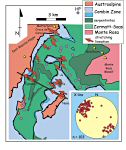 Valtournenche,
in the shadow of the Matterhorn, is a classic and important part of the western Alps. It contains a
number of key tectonic contacts including the base of the "upper plate" of the Alps (the so-called
Austroalpine sheet: represented here by the Dent Blanche klippe). In this part of the Alps this unit
contains no high pressure metamorphic rocks – it was never subducted to great depth. In contrast,
the oceanic units of the Zermatt-Saas zone contains eclogites, including some that were buried to depths
in excess of 120km. It is possible that the deepest structural unit in the current assemblage in Valtournenche,
the Monte Rosa massif was similarly deeply buried. Between the eclogites and the Dent Blanche klippe
lies a tract of strongly deformed metasediments (chiefly) derived from the old European continental
margin (called the Combin zone by some Alpine workers, others call it the Tsate nappe).
Valtournenche,
in the shadow of the Matterhorn, is a classic and important part of the western Alps. It contains a
number of key tectonic contacts including the base of the "upper plate" of the Alps (the so-called
Austroalpine sheet: represented here by the Dent Blanche klippe). In this part of the Alps this unit
contains no high pressure metamorphic rocks – it was never subducted to great depth. In contrast,
the oceanic units of the Zermatt-Saas zone contains eclogites, including some that were buried to depths
in excess of 120km. It is possible that the deepest structural unit in the current assemblage in Valtournenche,
the Monte Rosa massif was similarly deeply buried. Between the eclogites and the Dent Blanche klippe
lies a tract of strongly deformed metasediments (chiefly) derived from the old European continental
margin (called the Combin zone by some Alpine workers, others call it the Tsate nappe).
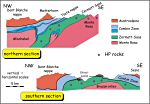 Classical
studies of Alpine geology have assumed a general nappe - stacking towards the NW. The timing of these
major displacements has also been considered to have happened before about 38 Myr. But as new geochronology
has emerged in the Alps, during the mid 1990s we conducted a multi-disciplinary structural, metamorphic
and geochronological study to deduce the kinematics and timing of these deformations.
Classical
studies of Alpine geology have assumed a general nappe - stacking towards the NW. The timing of these
major displacements has also been considered to have happened before about 38 Myr. But as new geochronology
has emerged in the Alps, during the mid 1990s we conducted a multi-disciplinary structural, metamorphic
and geochronological study to deduce the kinematics and timing of these deformations.
Here are some of the results.
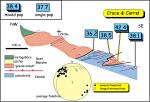 First,
the kinematic pattern in the Combin zone and on major contacts is complex. The base of the Dent Blanche
klippe shows top WNW and top ESE shear senses from place to place – indicating that this contact
is either reactivated or has been cut by later, top ESE shears. Shear sense in the Combin Zone is similarly
mixed. At individual outcrops it is possible to build up histories of sequential shear directions but
these are not correlatable between sites. In general however, the base of the Combin Zone (a major shear
zone) shows dominantly top ESE, layer-extensional shear fabrics. Such patterns are also found in the
Zermatt Saas but in general the deformation is much weaker at these deeper levels.
First,
the kinematic pattern in the Combin zone and on major contacts is complex. The base of the Dent Blanche
klippe shows top WNW and top ESE shear senses from place to place – indicating that this contact
is either reactivated or has been cut by later, top ESE shears. Shear sense in the Combin Zone is similarly
mixed. At individual outcrops it is possible to build up histories of sequential shear directions but
these are not correlatable between sites. In general however, the base of the Combin Zone (a major shear
zone) shows dominantly top ESE, layer-extensional shear fabrics. Such patterns are also found in the
Zermatt Saas but in general the deformation is much weaker at these deeper levels.
Overall the deformation style suggests that the Combin Zone is penetratively stretched and thinned out, while the underlying eclogites are less so. These deformations chiefly occurred under greenschist facies conditions (say about 20km down and at about 300-400C). But many mineral lineations defined by stable HP metamorphic assemblages are parallel, suggesting that deformation has progressed during exhumation.
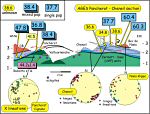 Timing
of shearing is rather difficult to assess directly. However, within the Dent Blanche units the mica
ages are aound 60 Myr. This is similar to results from the main Austroalpine units in Sesia and proably
reflect either cooling through about 500C or mica crystallization at this time. Within the Zermatt-Saas
zone the high pressure metamorphic assemblages have been dated by other workers at around 45 Ma (U-
Pb). The assumption is that the oceanic units were still at eclogite facies, maybe event at peak (120km
depth) at this time. The other units give a broad swathe of ages. Our microstructure/ microchemical
studies indicate that most samples contain mixtures of mica populations. The likelihood is that many
micas are inherited from earlier in the history and show pre- kinematic cooling or crystallization ages.
New mica growth at a younger age coincides with the main penetrative shearing. So ages are mixtures – with
the youngest ages likely to be true kinematic ages. Overall the deformation probably progressed from
about 37 to 34 Ma. Note that if the UHP metamorphic rocks were at peak conditions at 45 Ma they were
exhumed to shallow crustal levels, a vertical distance of about 100 km, in less than 10 million
years (time average vertical movement of 1 cm/yr).
Timing
of shearing is rather difficult to assess directly. However, within the Dent Blanche units the mica
ages are aound 60 Myr. This is similar to results from the main Austroalpine units in Sesia and proably
reflect either cooling through about 500C or mica crystallization at this time. Within the Zermatt-Saas
zone the high pressure metamorphic assemblages have been dated by other workers at around 45 Ma (U-
Pb). The assumption is that the oceanic units were still at eclogite facies, maybe event at peak (120km
depth) at this time. The other units give a broad swathe of ages. Our microstructure/ microchemical
studies indicate that most samples contain mixtures of mica populations. The likelihood is that many
micas are inherited from earlier in the history and show pre- kinematic cooling or crystallization ages.
New mica growth at a younger age coincides with the main penetrative shearing. So ages are mixtures – with
the youngest ages likely to be true kinematic ages. Overall the deformation probably progressed from
about 37 to 34 Ma. Note that if the UHP metamorphic rocks were at peak conditions at 45 Ma they were
exhumed to shallow crustal levels, a vertical distance of about 100 km, in less than 10 million
years (time average vertical movement of 1 cm/yr).
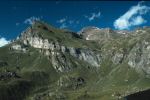 The "base
Combin" shear zone above Cheneil hamlet, Valtournenche (looking NNW). The white cliff-forming unit
is Triassic (?) carbonates that are strongly sheared. There are locally sheared "Permian" metavolcanics
below. The base of the slope contains Zermatt-Saas eclogite ophiolites. The upper slopes (on towards
Gran Tournalin) include metasediments, metabasics and serpentinites. About 1200m of visible topography
(highly foreshortened).
The "base
Combin" shear zone above Cheneil hamlet, Valtournenche (looking NNW). The white cliff-forming unit
is Triassic (?) carbonates that are strongly sheared. There are locally sheared "Permian" metavolcanics
below. The base of the slope contains Zermatt-Saas eclogite ophiolites. The upper slopes (on towards
Gran Tournalin) include metasediments, metabasics and serpentinites. About 1200m of visible topography
(highly foreshortened).
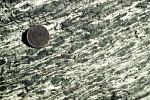 Strongly
sheared (greenschist facies) metagabbro from the Zermatt Saas zone below Lago Cignana. These highly
deformed rocks represent old oceanic crust, adjacent parts of which record peak metamorphic pressures
equivalent to being subducted to >100km. The shear fabrics relate to the exhumation of these rocks.
Looking south (can you determine the apparent shear sense?)
Strongly
sheared (greenschist facies) metagabbro from the Zermatt Saas zone below Lago Cignana. These highly
deformed rocks represent old oceanic crust, adjacent parts of which record peak metamorphic pressures
equivalent to being subducted to >100km. The shear fabrics relate to the exhumation of these rocks.
Looking south (can you determine the apparent shear sense?)
 Looking
south onto a vertical face of sheared calc schists, below the Carell's cross location. The s-c fabrics
imply a top-west shear sense.
Looking
south onto a vertical face of sheared calc schists, below the Carell's cross location. The s-c fabrics
imply a top-west shear sense.
 A
sheared quartz vein in the basement units of the Dent Blanche klippe at the Carell's cross section.
Looking north, the shear sense is top-east.
A
sheared quartz vein in the basement units of the Dent Blanche klippe at the Carell's cross section.
Looking north, the shear sense is top-east.
You can find out more from the summary paper ( pdf).
Fieldwork and lab-based research in Valtournenche and other areas north of the Aosta valley was carried out as part of a collaborative project with John Wheeler and colleagues (Liverpool) in conjunction with Simon Inger and Steve Freeman.
Title image: Cervino (Matterhorn) seen from the SE, looming over the ski centre of Cervinia. The mountain is part of the Dent Blanche klippe resting on a tract of "Combin Zone" material that runs out along the skyline to the right (Italy-Switzerland frontier ridge).
|| Alpine Tectonics || Evolution of the metamorphic western Alps ||